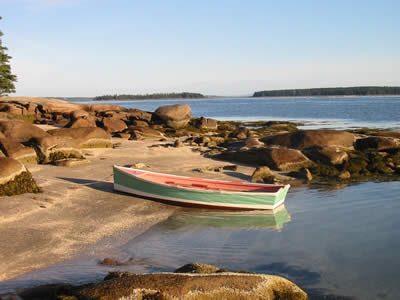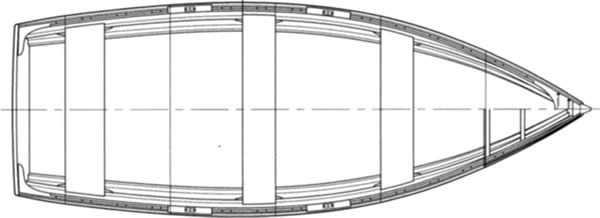A simple-to-build 11′ skiff, can be built up to 18′ long
Originally modeled by Fred Tripp and documented by R. H. Baker.

The Westport Skiff is a good example of a type that was ubiquitous on the US east coast in the early 1900s and probably well before. They were good all around boats, but their main virtue was simplicity of construction and low cost. A good builder could turn out one of these boats in a couple of day – one to build, one to paint. They were heavy, which didn’t matter once they were in the water, and the bottom planking would open up dramatically if left out of the water for any length of time. Thus, they were intended to spend the entire season in the water, likely as a tender for a larger workboat, or as an inexpensive boat for catching a few fish for dinner.

Nowadays, many of us are not able to leave our skiff in the water all the time, so light weight and freedom from leaks are more important. You probably won’t build this boat in a day – more likely a week or a month – but it is still a simple and fun boat to build. It would be ideal as a project with the kids, and a good boat for them once done. I would urge you to build the rowing version, as outboards can be a curse to peace-of-mind and the environment. And, kids should learn to row before being turned loose with a motor. In fact, there isn’t much of any excuse for the outboard version. It’s only virtue is that it gives a little more support a slightly bigger motor and a single occupant in the stern. I drew it only because I had a handicapped customer who physically could not row.
You can still put a little motor on the rowing version – about 2 hp is all it can use. But if you build the outboard version, its rowing qualities will be ruined with anything more that one middle sized kid at the oars. The transom will drag, the boat will slow dramatically and the fun of rowing will be gone. If you just can’t see yourself rowing at all, consider a little electric trolling motor with the battery up forward in the rowing version.
If you want a bigger boat, you can stretch out this one to any length up to about 18 feet. Just increase the longitudinal spacing of the measurements given on the plans to some number that gives you the length you want. Use the same molds and transom as shown, keeping the same beam. You will also need to alter the bevel on the inner stem and transom slightly – keep the same width on the outside faces and make the inside smaller to suit. If you do go all the way to 18′, you might want to increase the thickness of the topside panels to 3/8″, as 1/4″ will be difficult to handle at any length over about 16′.
This design is based on an original modeled by Fred Tripp and documented by R. H. Baker.

PARTICULARS
LOA – 11′
BEAM – 4′ 0″
DRAFT – approx. 3″
WEIGHT – approx. 100 lb.
HULL TYPE – flat bottom, transom stern
CONSTRUCTION – glued plywood
SUITABLE FOR – protected waters
TRAILERABLE – Yes
PROPULSION – oars or small outboard motor
SKILL REQUIRED – Beginner
LOFTING REQUIRED – no, full size patterns included
PLANS SHEETS – 2 sheets, folded in an envelope, via First Class Mail
PLANS DETAIL – Above average
INCLUDED WITH PLANS Copy of Bob Baker’s original building instructions
PLANS COST – $75.00 + S&H
STUDY PLANS
Click to download free study plans in PDF format.
PLANS
- You can order online using Paypal’s ordering system (which accepts Visa/MC/AmEx/Discover/eCheck/PayPal):
- You can see your Paypal Cart at any time by clicking the button below:
- You can also order plans by sending a check or money order to Hylan & Brown – Boatbuilders, 10 Frank Day Ln, Brooklin, ME 04616.
- Many questions are answered in Frequently Asked Questions. Please check there first.
- Contact us if you have any questions.